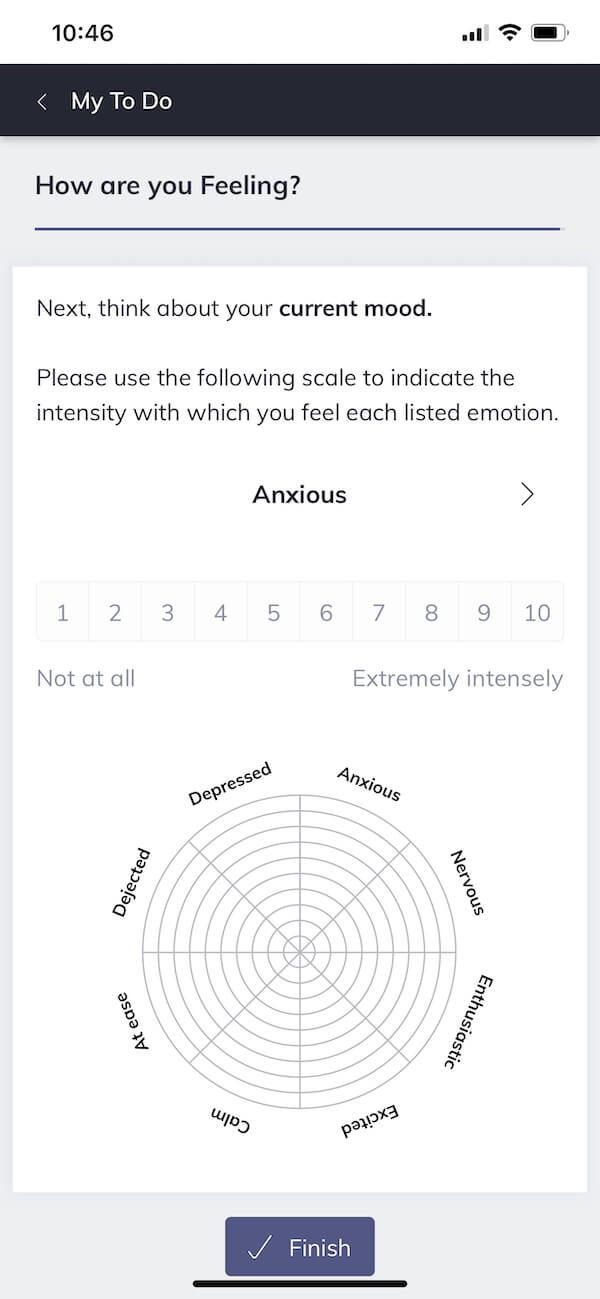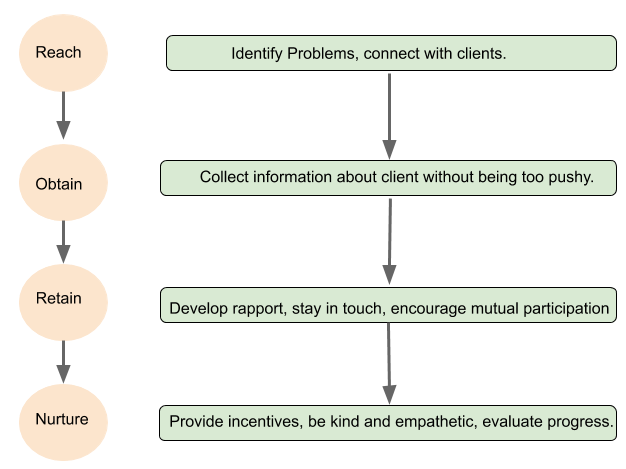What is Client Engagement in Therapy and How to Apply It?
 The outcome of psychotherapy is mostly dependent on the quality of the relationship between the therapist and the client.
The outcome of psychotherapy is mostly dependent on the quality of the relationship between the therapist and the client.
Any form of therapy requires self-disclosure from the client’s end and an immense commitment to bringing about the desired change.
Client engagement or treatment engagement in psychotherapy is one of the most significant aspects of the therapeutic process. It reflects the level of healthy attachment a client has with the therapist and directly impacts on the prognosis.
There are multiple identifiers of positive therapeutic engagement, some of which are:
- Regular attendance to the sessions.
- Self-disclosure and emotional catharsis.
- Willingness to have awkward conversations.
- Diligent participation in the exercises and activities during therapy.
- Client’s perception of the ultimate goals of the treatment.
In this article, we will take an in-depth look into the core aspects of client engagement and discuss ways to implement the same. The following sections shed light on how to internalize the concept of therapeutic involvement and apply it in real lives – both as a professional and a help seeker.
Before you continue, we thought you might like to download our three Goal Achievement Exercises for free. These detailed, science-based exercises will help you or your clients create actionable goals and master techniques to create lasting behavior change.
This Article Contains:
- What is Client Engagement in Psychotherapy? A Definition
- A Look at the Client Engagement Model
- How to Engage Clients in Therapy
- Strengthening Client Engagement Using Quenza
- 2 Client Engagement Activities
- PPT on Client Engagement
- Define Treatment Engagement
- What is Treatment Entry and Engagement in Mental Health?
- Treatment Engagement Rating Scale
- 4 Barriers to Treatment Engagement
- 3 Mental Health Engagement Strategies
- 2 Books on Client Engagement in Psychotherapy
- A Take-Home Message
- References
What is Client Engagement in Psychotherapy? A Definition
In general, engagement refers to the process of creating deep connections with clients that drive decisions, interaction, and participation, over time (Temkin, 2008).
Sarah Keenan and other eminent life coaches at the Holland Bloorview Kids Rehabilitation Hospital beautifully explained the meaning of client engagement in their excellent video ‘Knowledge Connection.’
Their presentation depicts client engagement as a healthy mutual connection that entails motivating the client, sustaining his faith throughout the sessions, and promoting a positive outcome at the end of the course.
In mental health sciences, engagement denotes all the efforts made during therapy, right from the intake sessions, to achieve the desired results. It is a multifaceted construct with several domains such as communication, participation, and exchange of valuable information (Holdsworth, Bowen, Brown, & Howat, 2014).
According to Bowlby (1988), engaging clients from the introductory session and sustaining the interest all along is essential for:
- Creating a safe environment for the client where he can express fearlessly.
- Exploring past achievements and failures that may be the source of current problems.
- Evaluating the pattern of attachment that the client has with other people in his life.
- Understanding how past relationships might be associated with his present condition.
- Modifying thoughts, perceptions, and actions to build positive relationships with his internal and external worlds.
A Look At The Client Engagement Model
The Client Engagement Model helps us in understanding the dynamics of therapeutic alliance and how it affects the upshot of therapy. Although it is mainly used in the corporate sectors, the principles of this model hold for therapeutic settings as well.
The Client Engagement (C.E.) model states that there are two stages of engaging a client into a process:
- The Onboarding Stage – Which is all about creating a healthy working relationship that would encourage him to participate actively.
- The Maintenance Stage – Which explores how to keep the client motivated and mindful throughout the sessions right from the beginning.
Each stage of the C.E. model is essential and reflects the differences between starting therapy and sustaining motivation for sessions in progress. The C.E. model (illustrated below) shows how a basic intervention plan can build active cooperation in treatment.
How to Engage Clients in Therapy
Carl Rogers was one of the first persons who emphasized the importance of engaging a client in therapy. His article in the Journal of Consulting Psychology mentioned that sustaining clients’ focus in the counseling sessions require:
- Continuous focus on building a strong alliance.
- Unconditional acceptance and zero judgment.
- Being empathetic at all times.
- Clear communication and active listening.
There is no one-size-fits-all concept when it comes to dealing with people and offering solutions to their unique problems (Rogers, 1957). Each one of us thinks differently, feels differently, and reacts to stress and burnout in totally independent ways. Therefore, client engagement in therapy has to follow a highly individualized approach to ensure clients benefit optimally from it.
At the root of successful engagement lies healthy attachment and exchange of positive emotions (Bowlby, 1987, 1988). Whether in an individual or a group session, the level of trust and unconditional positive regard between client and therapist determines client engagement to a large extent.
Successfully inducing and sustaining interest in therapy requires years of experience and insight. Most therapists believe the best way to master the art of client engagement is to practice it in and out actively.
Here are some well-known patterns of client engagement that can improve the possibility of success in psychotherapy.
Meeting and greeting
While basic as it may sound, beginning and ending the session with warm greetings and goodbyes is an excellent way to make the client feel welcome and cared.
Simple words such as ‘How are you doing today?‘ or ‘How has your day been so far?‘ are great icebreakers for resistant and non-communicative clients.
Confidentiality
Maintaining and respecting the client’s privacy is a prime concern for therapists in any field. It is natural for clients to gauge if it is safe to share personal information, and even the slightest breach may damage the process forever.
Therefore, therapists must ensure confidentiality and privacy at all times. They must not mention any information with anyone other than those who are involved with the case.
Using an eclectic approach
Clients may often get bored and lose interest in the therapy, especially if it has been going on for a while. To prevent this, many therapists mix and match their interventions and randomly implement them in the sessions.
Trying new approaches not only make clients feel more excited and curious, but it also improves the abilities of the therapist himself.
Make a well-planned treatment routine
Discussing the intervention strategy and techniques at the beginning and the end is a good step for ensuring client engagement. It helps the client to understand the road map and have something to look forward to.
Choose interventions according to the client’s interest
Different individuals have different areas of interest and passion. For example, for a travel-lover and nature-lover, using visual imagery of nature during therapy may help in soothing their mind and keep them motivated to participate more in the session.
Learning the clients’ likes and dislikes and intelligently incorporating them in therapy goes a long way in improving treatment engagement and outcome.
Strengthening Client Engagement Using Quenza

With the rise of digital technologies, therapists are finding new and innovative ways to strengthen client engagement with interventions, not only in the therapy room but between real-time sessions.
For example, using the e-therapy platform Quenza (pictured here), therapists can invite their clients to complete a range of self-paced psychoeducational activities that supplement their in-person learning.
Using the platform, therapists can design reflection exercises, readings, questionnaires, and a range of other activities, all of which clients can complete at their convenience on their personal devices.
A key advantage of using a digital platform like Quenza to prescribe interventions is that it allows therapists to track their clients’ progress from the practitioner’s end of the app.
Using the service, therapists can even send push notification reminders to their clients’ devices to complete activities, helping to keep them engaged and on track to achieving their therapy goals.
If you’re interested in learning more about Quenza, check out these psychoeducational interventions. And if you’d like to try the platform for yourself, the service offers a 30-day trial for just $1.
2 Client Engagement Activities
Client engagement is directly associated with positive outcomes for emotional problems, mood disorders, and substance abuse (LeBeau et al., 2013; Orlinsky, Grawe, & Parks, 1994). The most reliable indicator of engagement is regular attendance to sessions.
Here are two engagement activities that have been proven to be useful for treatment engagement in adults and adolescents (Wang et al., 2006).
Breathing room
Breathing room is a comfortable space that therapists often create for their clients. The method is prevalent for adolescents who sometimes struggle to open up and acceptably express their emotions.
In the breathing room, therapists explain why it is okay to take some moments to think or do something unrelated to therapy. It can be anything that clients enjoy doing, as long as it ensures their health and safety.
For example, spending the first few minutes of the session in a coffee shop can be a suitable breathing room for some clients. On the other hand, taking a short walk with the therapist and doing some small talk can be the right way for helping some clients open up (Shelef, Diamond, Diamond, & Liddle, 2005).
There are five steps of using breathing room in psychotherapy:
Step 1 – Acknowledge the fact that it is hard for clients to open up and share their problems with a stranger in the first place. Be empathetic to their struggles at all times.
Step 2 – Explain why therapy doesn’t have to be on the couch or in a closed room. Make the discussion easy by asking what the client loves to do during his spare time, or try to learn about his general interests in life.
Step 3 – Explain what a breathing room is and let your client choose one for himself. Offer multiple options (for example, sitting in a cafe, taking a short walk, looking through old pictures, etc.) and allow the client to choose what he thinks would be the best.
Step 4 – Engage with the client completely when you are in the breathing room and do not ask any questions that might make the client uncomfortable. Once the client feels free and ready in the breathing room, come back to the general therapy setting for the rest of the session.
Step 5 – Discuss the importance of being in the breathing room and evaluate what areas you can work on improving in the next session.
Music
Music is one common thing that interests all of us at some level or the other. It bridges the gap between verbal and nonverbal communication (Slyter, 2012). Using music in therapy is, by far, one of the most reliable and effective strategies for sustaining client engagement in treatment (Veach & Gladding, 2006).
Here are some ways we can use music as an active client engagement intervention. It works well for clients of all ages and backgrounds and adds meaning to the therapeutic alliance as a whole (Gardstrom, 2004).
Step 1 – Acknowledge the client’s struggle and empathize with his difficulty to open up or communicate.
Step 2 – Talk about music and discuss each other’s interests in songs or other forms of music. Make the conversation mutual – be careful not to be pushy, try to make it progress as a smooth flowing conversation about each others’ music interests.
Step 3 – Once the client willingly shares his likings, discuss how you could use music in the therapy sessions.
Step 4 – Introduce ideas such as sharing earphones in the session, keeping 5-10 minutes per session for music relaxation, singing or playing instruments once in a while, etc.
Step 5 – Evaluate the client’s level of satisfaction after participating in musical interventions and keep a note of their regularity to the sessions.
PPT on Client Engagement
A valuable PowerPoint presentation depicting client engagement.
Creating Engagement Strategies – Richard Sedley
Richard Sedley is a well-known author and an expert in the field of corporate client management. His works have been appreciated worldwide and are recognized as the most actionable measures on customer engagement in different occupations.
Although his actions are not explicitly designed for mental health professionals, his slideshow on the basics of the ‘what, why, and how’ of customer engagement is genuinely insightful and informative.
The presentation comes with relevant inputs on how to start engaging clients and build healthy professional bonds. It covers all aspects of client engagement that can be effectively incorporated in the health sciences as well.
Define Treatment Engagement
Treatment engagement is about creating a mutually beneficial client-therapist relationship to optimize the purpose of the treatment. Whether the client comes to an outpatient facility or is a residential patient, engaging him in the therapy sessions from day one is a top concern for all health professionals working with him.
Successful treatment engagement includes:
- Providing a positive, trustworthy, and comfortable environment to the client where he feels safe and heard.
- Incorporating effective response procedures – both verbal and nonverbal, that can facilitate communication between client and therapist.
- Preparing and executing well-structured interviews before intake and after the commencement of treatment.
What is Treatment Entry and Engagement in Mental Health?

For example, adolescents undergoing emotional struggles, trauma victims, and suicidal patients may have a hard time letting off their guard and opening up about their distress.
A healthy treatment engagement plan in such cases can lead to better prognosis of the psychopathology and help the client address his issues with more reality orientation. While several factors influence the effectiveness of the engagement plan, one of the most critical factors is treatment entry.
Studies have shown that the level of engagement that develops in the first few sessions give the most promising outcomes and sustains until the termination of therapy (Appel et al., 2004).
Treatment engagement is a purely recovery-oriented process. The sole purpose of engaging hesitant and rigid clients is to make sure they get over their temporary struggles and look at life from a more positive perspective.
Successful treatment engagement in psychotherapy helps clients in many ways. For example, it allows them to focus on what they want to achieve from the therapy and their expectations from the therapist. It also allows them to step up and decide on their actions and prioritize tasks accordingly.
On the other hand, reduced engagement in treatment, at any point in the therapy results in degradation of the whole process. Individuals with a terminal illness, aged people, or women with postpartum blues are some examples of demanding clients who are challenging to engage.
Treatment Engagement Rating Scale
The Treatment Engagement Rating (TER) Scale was initially a Dutch therapy instrument used for treatment engagement of forensic clients. TER is an objective measure that evaluates client engagement at three levels.
The items of the questionnaire are divided into nine components, each measuring an aspect of client involvement, and the summation of the scores are aggregated to obtain a final score for treatment engagement.
The TER, however self-scorable, is a professional test mostly used by therapists to evaluate the positive regard their client has towards the therapy. It has a high consistent reliability score and is a valid measure for predicting the level of client engagement and the overall outcome of the treatment.
The TER contains simple questions and is usually administered under professional supervision.
4 Barriers to Treatment Engagement

There are three primary sources of barriers to treatment engagement:
- Less motivation and apathy.
- Situational factors that restrict engagement.
- Lack of variation in treatment interventions for different clients.
Barriers to treatment engagement can come from both the client and the therapist. Some of the most common impediments to treatment engagement are:
Denial
Denial results in low motivation and ultimately leads to low engagement. Clients often fail to accept the severity of their actions and force themselves to believe that their thoughts and actions are beneficial for them (Jackson & Thomas-Peter, 1994).
For example, individuals with anger management and impulse control problems, or sex offenders seeking therapy often fail to see the distortion in their thoughts that led to the issues. Helping them overcome this denial at the early stage of intervention, for example by active communication, cognitive interventions, or other activities, can help in sustaining engagement throughout the sessions (Kennedy & Grubin, 1992).
Negative expectations
Many therapists agree that clients come with unrealistic expectations from the therapist. In some instances, they want their therapists to solve their problems magically. While in other cases, clients perceive the therapy to be a painful recapitulation of the stressful events that they are trying to get rid of (Garfield, 1994).
Personality factors
We know that treatment engagement is individualized and differs from person to person. Lack of knowledge about the personal disposition of the clients can create a significant obstacle in creating and sustaining treatment engagement in therapy (Winn, 1996).
For example, victims of domestic and sexual violence, who already have a weak sense of trust and self-esteem, may find it hard to open up in group settings in the beginning. Changing the intervention plan and execution according to the individual needs is one of the primary requisites for engagement in psychotherapy.
Power and control factors
A therapist usually has all the information about his client from the very beginning. But the client comes with minimal knowledge of who he is seeing and how the sessions will be. This may initially make some clients feel less convincing; however, with the right set of activities and positive communication, therapists can overcome this barrier in therapy (Marecek & Kravetz, 1998).
3 Mental Health Engagement Strategies
The most popular engagement strategies in mental health are – connection, compliance, and participation. They form the basis of engagement, and most interventions follow these strategies in one way or the other.
Connection
Building a secure connection with the client starts from the very first session. It can be formed through communication, active listening, empathy, and mutual trust. Building a therapeutic alliance guarantees client interest (Kazantzis, Whittington, & Dattilio, 2010; Morgan & Flora, 2002).
Some exciting ways for therapists to establish a therapeutic connection are:
- Offering some minutes for journaling clients’ thoughts and feelings after each session.
- Using simple metaphors that the client can relate to.
- Using a positive tone that can make the client feel comfortable and heard.
Compliance
Compliance is a sure shot indicator of treatment engagement but can be challenging to attain. A great strategy to enforce the arrangement is by introducing home assignments that clients would agree to do at home.
Compliance is a typical engagement strategy in CBT and uses a range of activities that can keep clients engaged even when they are in their personal spaces (Graff et al., 2009). Some examples of compliance activities are:
- Maintaining a daily thought journal where clients keep a record of their daily activities, thoughts, and emotions.
- Having a sleep journal to evaluate and monitor the quality of sleep.
- Specialized activities such as mood mapping or time-out, can help clients experiencing emotional and impulse control issues (Baydar, Reid, & Webster‐Stratton, 2003).
Participation
Engagement as participation or involvement is all about creating equality and making clients feel as powerful as the therapist (Dingle et al., 2008). Some strategies to promote client participation in mental health interventions are:
- Making the treatment plan in collaboration with the client. Therapist and client can sit together to discuss what they expect at termination and decide how to achieve the ultimate goal (Chatzisarantis, Hagger, Smith, & Sage, 2006).
- Engaging in active feedback sessions where both the therapist and the client can openly discuss what they like about the sessions and what they would like to change (Frankel & Levitt, 2009).
2 Books on Client Engagement in Psychotherapy
The following books have been selected because of their guidance on attaining client engagement.
 1. Principles of Trauma Therapy: A Guide to Symptoms, Evaluation, and Treatment – John Briere and Catherine Scott
1. Principles of Trauma Therapy: A Guide to Symptoms, Evaluation, and Treatment – John Briere and Catherine Scott
The Principles of Trauma Therapy is a specialized and rich content on the most effective ways of dealing with severe cases of trauma and abuse.
The book explores all the dynamics of a healthy client-therapist relationship and talks about some great ways to have clients engaged in therapy from day one.
It is evidence-based, focuses on applications, and guides professionals on how to get things done successfully.
Find the book on Amazon.
2. Engagement and Therapeutic Communication in Mental Health Nursing – Sandra Walker

The book is specially designed for mental health nurses and is a trustworthy resource that can facilitate professionals at all levels.
Find the book on Amazon.
A Take-Home Message
According to the famous American author W. Timothy Gallwey, “In every human endeavor, there are two areas of engagement – the outer and the inner.”
The different activities and engagement strategies we discussed in this article are examples of outer engagement. The inner engagement takes a deeper dive into creating insight and making clients feel confident and motivated to attend the sessions and meet the goals.
The groundwork of client engagement in psychotherapy is trust and confidentiality. When an individual realizes that he is safe to share his feelings without being judged, he will naturally feel more inclined to participate actively.
We hope you enjoyed reading this article. Don’t forget to download our three Goal Achievement Exercises for free.
- Appel, P. W., Ellison, A. A., Jansky, H. K., & Oldak, R. (2004). Barriers to enrollment in drug abuse treatment and suggestions for reducing them: Opinions of drug injecting street outreach clients and other system stakeholders. The American Journal of Drug and Alcohol Abuse, 30(1), 129-153.
- Baydar, N., Reid, M. J., & Webster-Stratton, C. (2003). The role of mental health factors and program engagement in the effectiveness of a preventive parenting program for Head Start mothers. Child Development, 74(5), 1433-1453.
- Bowlby, J. (1987). Defensive processes in the light of attachment theory. In D. P. Schwartz, J. L. Sacksteder, & Y. Akabane (Eds.), Attachment and the therapeutic process: Essays in honor of Otto Allen Will, Jr., M.D (pp. 63–79). Madison, CT: International Universities Press, Inc.
- Bowlby, J. (1988). Developmental psychiatry comes of age. The American Journal of Psychiatry, 145(1), 1-10.
- Chatzisarantis, N. L., Hagger, M. S., Smith, B., & Sage, L. D. (2006). The influences of intrinsic motivation on execution of social behaviour within the theory of planned behaviour. European Journal of Social Psychology, 36(2), 229-237.
- Dingle, G. A., Gleadhill, L., & Baker, F. A. (2008). Can music therapy engage patients in group cognitive behaviour therapy for substance abuse treatment? Drug and Alcohol Review, 27(2), 190-196.
- Gardstrom, S. (2004). An investigation of meaning in clinical music improvisation with troubled adolescents. Qualitative Inquiries in Music Therapy Monograph Series, 1, 77-160.
- Garfield, S. L. (1994). Research on client variables in psychotherapy. In A. E. Bergin & S. L. Garfield (Eds.), Handbook of psychotherapy and behavior change (pp. 190–228). Hoboken, NJ: John Wiley & Sons.
- Graff, F. S., Morgan, T. J., Epstein, E. E., McCrady, B. S., Cook, S. M., Jensen, N. K., & Kelly, S. (2009). Engagement and retention in outpatient alcoholism treatment for women. American Journal on Addictions, 18(4), 277-288.
- Holdsworth, E., Bowen, E., Brown, S., & Howat, D. (2014). Client engagement in psychotherapeutic treatment and associations with client characteristics, therapist characteristics, and treatment factors. Clinical Psychology Review, 34(5), 428-450.
- Jackson, C., & Thomas-Peter, B. A. (1994). Denial in sex offenders: workers’ perceptions. Criminal Behaviour and Mental Health, 4(1), 21-32.
- Kazantzis, N., Whittington, C., & Dattilio, F. (2010). Meta‐analysis of homework effects in cognitive and behavioral therapy: A replication and extension. Clinical Psychology: Science and Practice, 17(2), 144-156.
- Kennedy, H. G., & Grubin, D. H. (1992). Patterns of denial in sex offenders. Psychological Medicine, 22(1), 191-196.
- LeBeau, R. T., Mischel, E. R., Simpson, H. B., Mataix-Cols, D., Phillips, K. A., Stein, D. J., & Craske, M. G. (2013). Preliminary assessment of obsessive-compulsive spectrum disorder scales for DSM-5. Journal of Obsessive-Compulsive and Related Disorders, 2(2), 114-118.
- Marecek, J., & Kravetz, D. (1998). Power and agency in feminist therapy. In I. B. Seu & M. C. Heenan (Eds.), Feminism and psychotherapy: Reflections on contemporary theories and practices (pp. 13-29). London, UK: Sage.
- Morgan, R. D., & Flora, D. B. (2002). Group psychotherapy with incarcerated offenders: A research synthesis. Group Dynamics: Theory, Research, and Practice, 6(3), 203-218.
- Orlinsky, D. E., Grawe, K., & Parks, B. K. (1994). Process and outcome in psychotherapy: Noch einmal. In A. E. Bergin & S. L. Garfield (Eds.), Handbook of psychotherapy and behavior change (pp. 270–376). Hoboken, NJ: John Wiley & Sons.
- Rogers, C. R. (1957). The necessary and sufficient conditions of therapeutic personality change. Journal of Consulting Psychology, 21(2), 95-103.
- Shelef, K., Diamond, G. M., Diamond, G. S., & Liddle, H. A. (2005). Adolescent and parent alliance and treatment outcome in multidimensional family therapy. Journal of Consulting and Clinical Psychology, 73(4), 689-698.
- Slyter, M. (2012). Creative counseling interventions for grieving adolescents. Journal of Creativity in Mental Health, 7(1), 17-34.
- Temkin, B. D. (2008). The customer experience journey. Forrester Research. Retrieved from https://www.forrester.com/report/The+Customer+Experience+Index+2008/-/E-RES45192#
- Veach, L. J., & Gladding, S. T. (2006). Using creative group techniques in high schools. The Journal for Specialists in Group Work, 32(1), 71-81.
- Wang, M. N., Sandberg, J., Zavada, A., Mittal, M., Gosling, A., Rosenberg, T., … & McPheters, J. (2006). “Almost there”… Why clients fail to engage in family therapy: An exploratory study. Contemporary Family Therapy, 28(2), 211-224.
- Winn, M. E. (1996). The strategic and systemic management of denial in the cognitive/behavioral treatment of sexual offenders. Sexual Abuse: A Journal of Research and Treatment, 8(1), 25-36.
Let us know your thoughts
Read other articles by their category
- Body & Brain (49)
- Coaching & Application (57)
- Compassion (26)
- Counseling (51)
- Emotional Intelligence (24)
- Gratitude (18)
- Grief & Bereavement (21)
- Happiness & SWB (40)
- Meaning & Values (26)
- Meditation (20)
- Mindfulness (45)
- Motivation & Goals (45)
- Optimism & Mindset (34)
- Positive CBT (28)
- Positive Communication (20)
- Positive Education (47)
- Positive Emotions (32)
- Positive Leadership (18)
- Positive Parenting (4)
- Positive Psychology (33)
- Positive Workplace (37)
- Productivity (16)
- Relationships (46)
- Resilience & Coping (36)
- Self Awareness (21)
- Self Esteem (38)
- Strengths & Virtues (32)
- Stress & Burnout Prevention (34)
- Theory & Books (46)
- Therapy Exercises (37)
- Types of Therapy (64)







What our readers think
Using the APA citation format to cite this article in my paper I should also include the year in which this article was written. I am unable to find this information on this page.
Hi SD,
This article was written in 2019. Hope this helps! 🙂
– Nicole | Community Manager
A great article but I can’t see any references fully cited, I’d like to follow up on some of the authors mentioned in the article.
Hi Jan,
Apologies that these references weren’t included before. You’ll now find them at the end of the article. 🙂
– Nicole | Community Manager
Hello, you mention your references are at the end of the article but I dont see them still?
Hi Sandra,
If you scroll down to where it says “How useful was this article to you?” immediately above this you’ll see a grey button that says ‘References’ with a plus sign you can click (or just search ‘References’ in your browser to find it).
– Nicole | Community Manager
Good evening Dr. Celestine,
How are you? I pray all is well!
My name is Lisa. I am doing a training and I wanted to get permission to use the client engagement model picture above. I will cite this website as my reference. If there is something else I need to cite, I will be glad to do that!
Best,
Lisa
Hi Lisa,
You can reference the image by referencing this article in APA 7th as follows: Roy Chowdhury, M. (2019, October 22). What is Client Engagement in Therapy and How to Apply It?. PositivePsychology.com. https://positivepsychology.com/client-engagement/
Hope this helps!
Kind regards,
Julia | Community